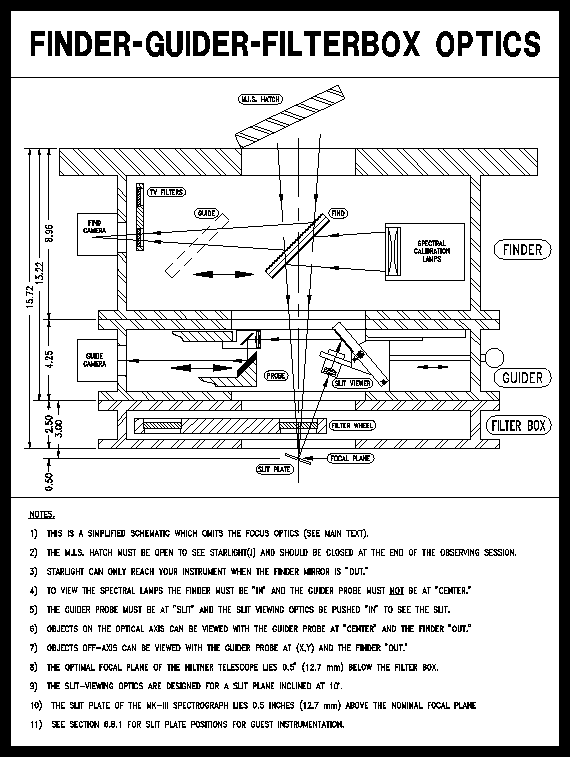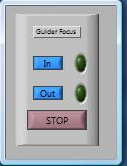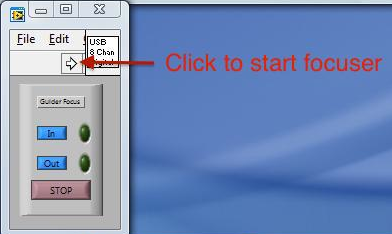
6 The Multiple Instrument System (MIS)
6.1 Introduction
The Multiple Instrument System (MIS) is comprised of three discrete and independent modules that can be used with a suite of analytical instruments: finder, guider and filterwheel (Figure 6-1).
The Finder module contains spectral calibration (Ne, Ar, Hg-Ne & Xe) and flat field lamps. It is of note that the Finder module is no longer equipped with a video camera as shown in Fig. 6-1.
The OSU Buckeye filter wheel module, which also contains a shutter, is used with imaging detectors and some spectrographs when employed as image reduction systems.
The MIS modules are attached to the instrument rotator (Chapter 8) and thus, changing the rotator angle will alter the orientation of the finder and guider fields. At the time of this update (2014Jan), the image rotator is not usable without some modifications to cable routing.
The operation of the MIS is linked with several other units that must be turned on for acquisition and guiding (Figure 6-2). Please be aware that Figure 6-2 is out-of-date, although it still is a good primer for the MIS system. Many components, including the Find camera, FIND/GUIDE Camera Selector, Digital Television Integrator, FIND/GUIDE TV Monitor, and SPARC2 computer have all been removed. A simple system replacement contains an FLI CCD used for auto-guiding, connected via USB to a Windows-based PC in the control room (we hope to update the drawing as time permits).
The MIS modules communicate through the MIS control crate, which is located in the right center instrument rack of the computer room. The front panel contains simply a power switch while a bank of fuses are located on the back panel.

6.2 The MIS Camera
The guider is equipped with a low-light-level Finger Lakes Instrumentaion (FLI) CCD that gives a real time display on the Guider PC. Numerous user-settings, such as CCD temperature, binning, exposure rate, etc. can be modified as the observer sees appropriate.
The guide camera has a "wall-wart" power supply, mounted on the instrument rotator flange. These units are normally left ON; they must be powered down when the camera cables are disconnected to avoid damage to the CCD.
Note that the display orientation changes with position angle of the instrument rotator (Chapter 8), although currently you should assume that the rotator is not in use.
If you experience difficulty in acquiring objects in the guider, consult Figure 6-3 for a system checkout.

6.3 The Multiple Instrument System Control Software, xmis2
The MIS control crate is operated from the observer's console (mdm13ws1), where commands to operate the various slides, lamps and filter wheels are entered through the xmis2 GUI (Figure 6-4). When the filter wheel is not used, the information on the filters is not displayed in the window. (The astute reader will notice that the image above is of xmis2 at the 2.4m. Rest assured, they are equivalent between the two telescopes.)
This chapter assumes you are familiar with all of Chapter 4. Start-up procedures for the software are described in Section 4.3.4.
When the software is loaded, a large red box with the word INITIALIZE appears. Click on this to initialize communications with the MIS control crate. Use the xmis2 SETUP menu to Initialize or Quit the software at any time. If one or more of the modules fails to initialize using xmis2, but continues after pressing the reset button on the control crate, check the fuses at the back of the control crate.
6.4 Finder
The Finder is used for spectroscopic calibrations or for lamp-based flat fielding. If the Finder is set to the "IN" position, then it is in the optical path and ready for calibration use. For on-sky observing, the Finder is set to the "OUT" position.
For spectroscopic calibration, move the Finder "IN" and choose the appropriate lamp(s). If the lamp button is highlighted in green, it is on. Make sure that the Guide Probe is not blocking the slit [Guider: S (14700,0)]. For best results, darken the environment to prevent "light leaks"--close the doors, turn off the lights and close the dark hatch. Remember to turn off the lamp(s) when done. This can be done by either clicking the appropriate lamp button a second time, or by simply clicking the All Off button.
6.5 Guider
The FINDER mirror must be OUT to allow starlight to reach the
guider
and your instrument.
An autoguider is available and is described in
Chapter 7, which
assumes that you are familiar with the contents of this section.
The guider has a diagonal probe whose minor axis is 25.4 mm. The probe can move in x and y directions as specified in Figure 6.5.
The probe has three basic positions accessible through the Preset pop-up menu:
6.5.1 xmis2 guider parameters; preset pop-up menu
The probe can be moved to the first three positions by selecting the destination in the xmis2 Preset pop-up window. The coordinates of the guider probe, together with the message [O], [C] or [S] are displayed in the xmis window:
| Origin: | Guider: O | (0, | 0) |
| Center: | Guider: C | (14700, | 17000) |
| Slit: | Guider: S | (14700, | 0) |
6.5.2 Off-axis guiding for direct imaging
The probe can move off-axis in x and y directions as specified in Figure 6-5.

There are two ways to move to an off-axis position, using either absolute or incremental instructions.
6.6 How to Focus the Guider and Instrument
This section assumes you are familiar with the preceding sections. The procedure is different for direct imaging and spectroscopy. Once everything is aligned and focused you can note the field centers.
6.6.1 Focus procedure: direct imaging


6.6.2 Focus procedure: spectroscopy
6.7 Filter Wheels and Filters
6.7.1 Four-inch filter wheel
The OSU "Buckeye" filter wheel can be used for any direct-imaging setup (MDM or 4k CCDs). It is controlled via the xmis2 GUI interface. It is a 12-position filter wheel, holding up to 11 4"-square filters at a time (slot 12 is usually reserved as an open pass-through). Typically, 2"-square filters can also be mounted in modified filter holders as well.
6.7.2 MDM filter sets
4" UBVRI filter set: In 2004 MDM received a set of four-inch square filters for use in the new filter wheel. They were supplied by Custom Scientific, Inc. to the same specifications as the 1999 2" UBVRI filters.
4" DES-i, z, Y
4" SDSS-g, r, i
2" h-alpha
2" 893/13.6
2" Gunn-u, g, v, r, i
2" Kitt Peak-R, I
Transmission curves and other data for filters can be found here: MDM filters for CCD imaging. If you request any of these filters they will be installed for you by the staff. If you have special requests for filters that aren't listed here, ask MDM staff in advance and we will see what might be available.6.8 Technical Reference Section
6.8.1 Guest Instrumentation and the MIS mounting plate
The finder, guider and filterbox modules of the MIS all have the same basic 12 mounting holes (Figure 6-6). These holes, 0.625 DIA, take reducing bushings and nuts. These are available in stainless steel and nylon. An electrical isolating spacer, made of G10, is also available.
The vertical height of each box is shown in Figure 6-1; a variety of back focal distances can be accommodated by using a combination of the modules:
| Modules used | remaining back focal distance (inches) |
| none | 15.72 |
| Finder | 7.25 |
| Finder + Guider | 3.00 |
| Finder + Guider + Filter wheel | 0.50 |
If the MIS is not used at all, instrumentation can be mounted directly on the instrument rotator (Chapter 8). The MDM 8K Camera does not use the MIS.
The diameter of the central hole in the FINDER and GUIDER boxes is 177.8 mm (7.0 inches), and the unvignetted field diameter of the telescope at f/7.5 is 125 mm (5 inches). The guid probe and the slit-viewing optics both vignette this field (Figure 6-5).
The slit viewing optics were designed for use with a focal plane 63.5 mm (2.50 inches) below the guider box. The optimal focal plane of the telescope, however, lies 76.2 mm (3.00 inches) below the guider. The slit viewing optics can be adjusted to accommodate slit planes from approximately 50 to 81 mm (2.0 to 3.2 inches) below the guider box. The FILTER WHEEL has, in addition to the 12 mounting holes around the perimeter which take the reducing bushings, 8 holes tapped 1/4- 20 as shown. The central hole is 2.25 inches in diameter.
The maximum total weight of the instrument depends upon its distance and distribution from the instrument rotator, and is approximately 500 pounds (225 kg). A moving platform allows heavy instruments to be raised for attachment to the telescope. Please consult the staff at an early stage if you plan on bringing out your own instrumentation.

6.8.2 xmis2 software configuration (for staff use only)
Staff notice for instrument changes: The xmis2 software needs to know which of the three MIS modules are installed. The telconfig script is used to setup both the TCS and MIS configuration for a given telescope and instrument combination. See the Startup Guide for details.
| < Prev (Telescope Control System) | Table of Contents | Next (Autoguider) > |